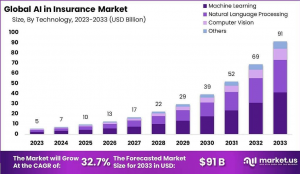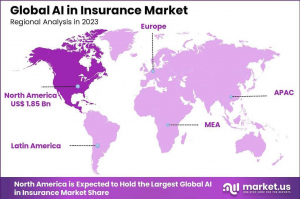AI in Insurance Market Help Boost Customer Service Efficiency USD 91 Billion by 2033, CAGR With 32.7%
In 2023, North America held a dominant market position in the AI in the insurance sector, capturing more than a 37% share of the global market...
AI technologies, such as predictive analytics, natural language processing, and robotic process automation, enable insurers to automate complex processes, improve decision-making, and provide superior customer service. The market is characterized by significant adoption of these technologies across the board, from established insurance firms to nimble insurtech startups.
🔴 𝐃𝐨𝐰𝐧𝐥𝐨𝐚𝐝 𝐄𝐱𝐜𝐥𝐮𝐬𝐢𝐯𝐞 𝐒𝐚𝐦𝐩𝐥𝐞 𝐨𝐟 𝐭𝐡𝐢𝐬 𝐏𝐫𝐞𝐦𝐢𝐮𝐦 𝐑𝐞𝐩𝐨𝐫𝐭 @ https://market.us/report/ai-in-insurance-market/request-sample/
A key driver is the ability of AI to optimize operations, reduce costs, and enhance customer satisfaction through faster, more accurate service. However, challenges remain, including ensuring the ethical use of AI to prevent bias and discrimination and overcoming the substantial investments required in data infrastructure and skilled personnel. Overall, AI in insurance is not only revolutionizing traditional practices but also shaping future-ready operational models that emphasize agility, efficiency, and customer-centric approaches.
Key Takeaways
The Global AI in Insurance Market size is expected to be worth around USD 91 Billion by 2033, from USD 5 Billion in 2023, growing at a CAGR of 32.7% during the forecast period from 2024 to 2033.
The Software segment held more than a 67% market share in 2023 due to its critical role in deploying AI technologies.
Machine Learning dominated with a 45% market share because of its versatility and efficiency in optimizing operations.
Large Enterprises captured more than a 70% share due to their capacity to invest in advanced AI infrastructures.
Underwriting and Claims Assessment held a dominant position with a 27% market share.
🔴 𝐇𝐮𝐫𝐫𝐲 𝐄𝐱𝐜𝐥𝐮𝐬𝐢𝐯𝐞 𝐃𝐢𝐬𝐜𝐨𝐮𝐧𝐭 𝐅𝐨𝐫 𝐋𝐢𝐦𝐢𝐭𝐞𝐝 𝐏𝐞𝐫𝐢𝐨𝐝 𝐎𝐧𝐥𝐲 @ https://market.us/purchase-report/?report_id=118716
Experts Review
Experts emphasize that government incentives and technological innovations are pivotal in driving the AI in Insurance market forward. Government support through incentives helps mitigate the high costs associated with AI implementation, facilitating broader adoption among insurers. Technological advancements, particularly in machine learning and data analytics, enhance insurers' abilities to manage risks and process claims efficiently, thereby revolutionizing customer service and operational dynamics.
Investment opportunities in this sector are lucrative but come with risks such as potential biases in AI decision-making systems and the challenges of integrating new technologies with existing legacy systems. The awareness of AI's benefits is growing, reflecting its technological impact—streamlining operations and enriching customer interactions through more personalized services.
Regulatory environments pose significant challenges. Insurers must navigate complex data protection laws and ensure ethical AI usage, particularly in underwriting and customer profiling applications. Despite these hurdles, the market outlook remains positive. The ongoing transformation of insurance models through AI reflects a shift toward more efficient, customer-centered services, driven by technological advancements and strategic government policies. This transition underscores AI's potential to reshape the industry's future, paving the way for more innovative and responsive insurance solutions.
🔴 𝐕𝐢𝐞𝐰 𝐏𝐃𝐅 𝐑𝐞𝐬𝐞𝐚𝐫𝐜𝐡 𝐒𝐚𝐦𝐩𝐥𝐞 @ https://market.us/report/ai-in-insurance-market/request-sample/
Report Segmentation
The AI in Insurance market is segmented by component, technology, enterprise size, and application. By Component, the market is divided into Hardware, Software, and Services, with the Software segment holding over 67% share in 2023. Software plays a crucial role in deploying AI technologies, managing vast datasets, and executing AI functionalities such as machine learning and natural language processing.
By Technology, Machine Learning dominates, capturing more than a 45% share due to its efficient capabilities in pattern recognition and predictive analytics. This technology enhances risk assessment models and fraud detection, critical for modernizing insurance operations.
By Enterprise Size, the market is divided into Large Enterprises and SMEs, with Large Enterprises holding a dominant 70% market share. Their extensive resources and capacity to invest in AI technologies enable comprehensive digital transformation initiatives.
By Application, areas like Fraud Detection and Credit Analysis, Customer Profiling and Segmentation, Product and Policy Design, and Underwriting and Claims Assessment are pivotal. Underwriting and Claims Assessment leads with a 27% market share, highlighting AI's crucial role in improving risk evaluation and claims processing efficiency. These segments showcase the diverse applications and benefits of AI in revolutionizing insurance processes, driving growth and innovation across the industry.
Key Market Segments
By Component
Hardware
Software
Service
By Technology
Machine Learning
Natural Language Processing
Computer Vision
Others
By Enterprise Size
Large Enterprises
SMEs
By Application
Fraud Detection and Credit Analysis
Customer Profiling and Segmentation
Product and Policy Design
Underwriting and Claims Assessment
Others
🔴 𝐆𝐞𝐭 𝐭𝐡𝐞 𝐅𝐮𝐥𝐥 𝐑𝐞𝐩𝐨𝐫𝐭 𝐚𝐭 𝐄𝐱𝐜𝐥𝐮𝐬𝐢𝐯𝐞 𝐃𝐢𝐬𝐜𝐨𝐮𝐧𝐭 (𝐋𝐢𝐦𝐢𝐭𝐞𝐝 𝐏𝐞𝐫𝐢𝐨𝐝 𝐎𝐧𝐥𝐲) @ https://market.us/purchase-report/?report_id=118716
Drivers, Restraints, Challenges, and Opportunities
Drivers: The integration of AI in insurance significantly boosts operational efficiency and reduces costs. AI automates processes like data entry and claims handling, which reduces human error and accelerates processing times. This operational streamlining leads to cost reductions and enhanced customer satisfaction. Additionally, AI's predictive analytics improve risk assessment and fraud detection, minimizing financial losses.
Restraints: Despite its benefits, high initial costs and the need for skilled AI professionals can limit adoption. Smaller insurers might struggle with investment in necessary data infrastructure, creating a digital divide between larger and smaller companies.
Challenges: Integrating AI with existing legacy systems poses significant challenges. Many insurance firms operate outdated platforms not equipped for AI's heavy data load. Overcoming these technical barriers requires investment and can be disruptive. Additionally, regulatory hurdles, such as compliance with data privacy laws, complicate AI adoption.
Opportunities: AI opens vast opportunities for personalized insurance products. By analyzing customer behavior data, insurers can tailor products more closely to individual needs, offering customized policies that increase customer satisfaction and loyalty. This personalization enables companies to differentiate their offerings in a competitive market, driving growth and attracting customers seeking flexible, personalized solutions.
Key Player Analysis
In the AI in Insurance market, leading players like IBM Corporation and Oracle Corporation play crucial roles. IBM, known for its advancements in cognitive computing and machine learning, revolutionizes claims processing and customer service through its AI solutions, enhancing accuracy and efficiency.
Oracle excels with its comprehensive cloud-based solutions that boost data analysis and decision-making capabilities. Afiniti and Cape Analytics contribute by improving customer interactions and property data analysis. CCC Information Services and Clara Analytics focus on automating claims management and risk assessments, thus reducing processing times and improving accuracy.
Cytora and Flyreel enhance underwriting processes and customer engagement using advanced data analytics and automated property inspections. These companies drive innovation by deploying state-of-the-art AI technologies that transform traditional insurance practices, fostering a competitive and innovative landscape. Their efforts not only improve operational efficiencies but also enhance customer satisfaction, setting industry standards and advancing the market's development.
Top Market Leaders
Afiniti
Cape Analytics
CCC Information Services
Clara Analytics
Cytora
Flyreel
Applied Systems
Cape Analytics
OpenText Corporation
IBM Corporation
Oracle Corporation
Pegasystems Inc
Quantemplate
Other Key Players
Recent Developments
Recent developments in the AI in Insurance market highlight ongoing advancements and strategic collaborations. In June 2023, Simplifai launched InsuranceGPT, a groundbreaking AI tool tailored for the insurance sector. Developed on a no-code platform, InsuranceGPT facilitates business process automation and enhances efficiency in insurance operations.
In April 2023, ACTYV.AI, a Singapore-based SaaS platform, partnered with Bajaj Allianz General Insurance to deliver insurance solutions via ACTYV.AI’s technology platform. This collaboration aims to promote sustainability across the supply chain by providing innovative insurance products for distributors, suppliers, and retailers.
These initiatives underscore the continuous drive towards integrating advanced technologies and fostering partnerships to enhance insurance industry capabilities. Such developments pave the way for more sophisticated, efficient, and customer-oriented AI applications, strengthening the market's appeal and fostering a more resilient and adaptable insurance ecosystem in response to evolving consumer needs and technological advancements.
Conclusion
The AI in the Insurance market is set for considerable growth, driven by substantial investments in AI technologies that transform risk management, claims processing, and customer interactions. Leading companies like IBM and Oracle are spearheading innovations, setting standards for efficient, AI-driven solutions.
Despite challenges such as high implementation costs and data privacy concerns, significant opportunities exist for personalizing insurance products and enhancing customer satisfaction. As more insurers adopt AI, the industry is expected to evolve, prioritizing improved efficiency and customer-centric strategies. This ongoing evolution underscores AI's pivotal role in shaping the future of the insurance sector.
➤ 𝐄𝐱𝐩𝐥𝐨𝐫𝐞 𝐎𝐭𝐡𝐞𝐫 𝐈𝐧𝐭𝐞𝐫𝐞𝐬𝐭𝐞𝐝 𝐓𝐨𝐩𝐢𝐜𝐬
IP Camera Market - https://market.us/report/ip-camera-market/
MIDI Controller Market - https://market.us/report/midi-controller-market/
Shooting Games Market - https://market.us/report/shooting-games-market/
Generative AI in FMCG Market - https://market.us/report/generative-ai-in-fmcg-market/
Music Streaming Market - https://market.us/report/music-streaming-market/
AI in Audit Market - https://market.us/report/ai-in-audit-market/
AI In Trading Market - https://market.us/report/ai-in-trading-market/
Generative AI In Animation Market - https://market.us/report/generative-ai-in-animation-market/
Auto-boxing Technology Market - https://market.us/report/auto-boxing-technology-market/
Generative AI in Material Science Market - https://market.us/report/generative-ai-in-material-science-market/
Lawrence John
Prudour
+91 91308 55334
Lawrence@prudour.com
Visit us on social media:
Facebook
LinkedIn
Legal Disclaimer:
EIN Presswire provides this news content "as is" without warranty of any kind. We do not accept any responsibility or liability for the accuracy, content, images, videos, licenses, completeness, legality, or reliability of the information contained in this article. If you have any complaints or copyright issues related to this article, kindly contact the author above.



